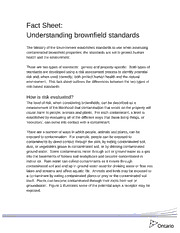
Fact sheet : understanding brownfield standards PDF
Preview Fact sheet : understanding brownfield standards
Fact Sheet: Understanding brownfield standards The Ministry of the Environment establishes standards to use when assessing contaminated brownfield properties; the standards are set to protect human health and the environment. There are two types of standards: generic and property-specific. Both types of standards are developed using a risk assessment process to identify potential risk and, when used correctly, both protect human health and the natural environment. This fact sheet outlines the differences between the two types of risk-based standards. How is risk evaluated? The level of risk, when considering brownfields, can be described as a measurement of the likelihood that contamination that exists on the property will cause harm to people, animals and plants. For each contaminant, a level is established by evaluating all of the different ways that these living things, or ‘receptors’, can come into contact with a contaminant. There are a number of ways in which people, animals and plants, can be exposed to contamination. For example, people can be exposed to contaminants by direct contact through the skin, by eating contaminated soil, dust, or vegetables grown in contaminated soil, or by drinking contaminated ground water. Some contaminants move through soil or ground water as a gas into the basements of homes and workplaces and become concentrated in indoor air. Rain water can collect contaminants as it moves through contaminated soil and end up in ground water used for drinking water or flow into lakes and streams and affect aquatic life. Animals and birds may be exposed to a contaminant by eating contaminated plants or prey or the contaminated soil itself. Plants can become contaminated through their roots from soil or groundwater. Figure 1 illustrates some of the potential ways a receptor may be exposed. What is the difference between Generic Standards and Risk Assessment (Property Specific) Standards? There are two risk-based approaches used to determine appropriate clean-up standards for specific contaminants: the generic approach and a property- specific approach. Both approaches are protective of human health and the natural environment, when used correctly. The property-specific approach, also known as the risk assessment approach, is used to develop standards which incorporate information about the conditions and characteristics of a specific property when calculating risk. Not all of the ‘receptors’ which are considered in the development of generic standards will exist at every property in the province. Information about the property and potential uses may indicate that certain types of exposure are unlikely to occur at a particular site. For example, there are sites where concerns about contaminants moving into groundwater that may be used for drinking water is not an issue if the water table is deep enough to prevent such an occurrence. Therefore, these exposures can be safely left out of the risk assessment when developing property specific standards for that site. Physical features and conditions at a property, such as soil particle size, organic carbon content, depth to groundwater, and proximity to a water body, can affect a contaminant’s behavior as well as the types of exposures possible at a particular site. Site specific measurement of those conditions may be different from the conditions that were assumed in the development of the generic standards. Page 2 of 3 For these reasons, property-specific standards developed in a risk assessment may be different than the generic standards. Because specific information about the property has been taken into account, however, such property-specific standards are as protective of human health and the natural environment as generic standards, which must take into account the overwhelming majority of potential risks at properties across Ontario. More information For more information on Brownfields redevelopment or additional copies of this brochure, please contact the MOE’s Public Information Centre at 416-325-4000 or toll-free (from outside the 416 area) at 1-800-565-4923, visit the Record of Site Condition website at: http://www.ene.gov.on.ca/environment/en/subject/brownfields/index.htm or call your local ministry regional office. Disclaimer This fact sheet has been developed to provide general information about the standards applied to brownfield properties when someone is conducting environmental site assessment and filing a record of site condition. As it summarizes complex matters and reflects legislation, policies and practices that are subject to change, it should not be relied upon as a substitute for specialized legal or professional advice in connection with any particular matter. Reference should always be made to the text of the Records of Site Condition Regulation (O. Reg. 153/04) and the Environmental Protection Act to ascertain specific legal requirements. Where there is a discrepancy between this fact sheet and O. Reg. 153/04 or the Environmental Protection Act, the regulation or Act prevails. The Act and its regulations may be obtained from Ontario’s e-laws website at www.e-laws.gov.on.ca or by calling the Ministry’s Public Information Centre at 1-800-565-4923. PIBS 7757e - July 2007 Page 3 of 3
